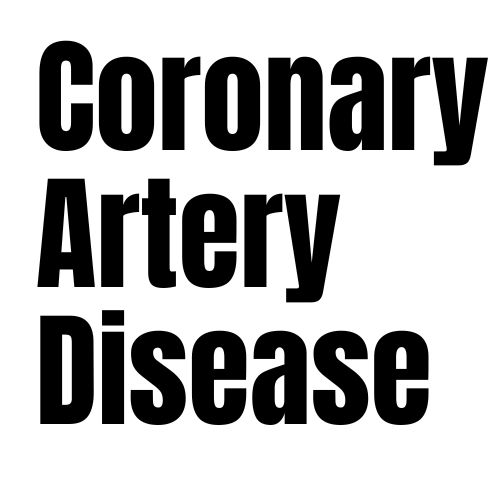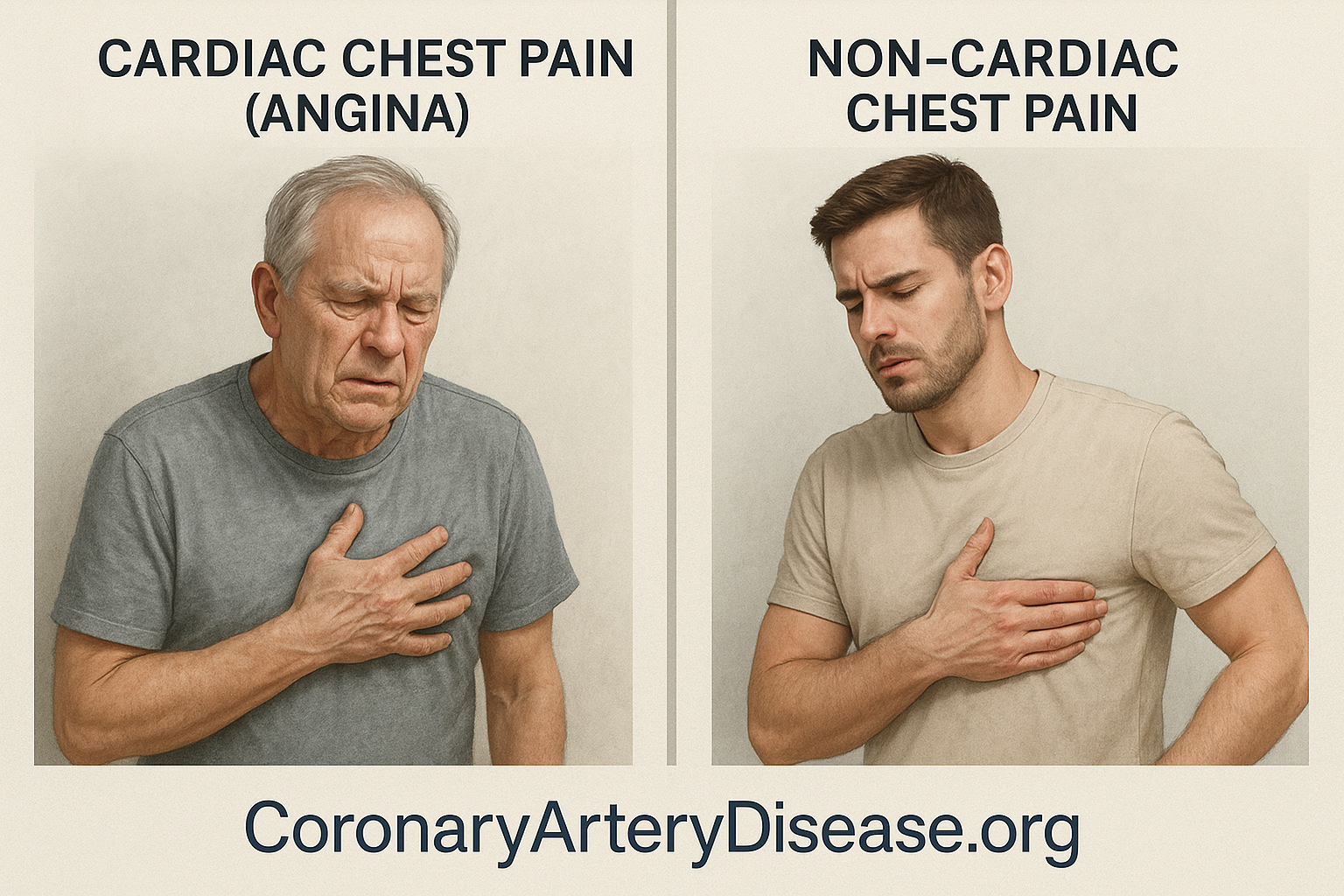Overview
Understanding these symptoms is crucial because early detection and management can significantly improve outcomes. The way Coronary Artery Disease presents can vary greatly among individuals, ranging from no noticeable symptoms to severe and life threatening events. It’s important to be aware of the different ways this condition can manifest, as recognizing them promptly can lead to timely medical attention.
Symptoms of Coronary Artery Disease
Here is a quick list of common symptoms associated with Coronary Artery Disease:
- Chest pain or discomfort (Angina Pectoris)
- Shortness of breath (Dyspnea)
- Fatigue
- Nausea
- Sweating (Diaphoresis)
- Fainting (Syncope)
- Palpitations (a feeling of your heart pounding or racing)
- Cardiac arrest or sudden cardiac death
- Atypical symptoms, especially in women, the elderly, and diabetics
- Silent ischemia (no symptoms at all)
In Details:
1. Angina pectoris
The most common symptom of Coronary Artery Disease is angina pectoris, often simply called angina. This is a clinical syndrome characterized by discomfort in the chest. People often describe it as a tight, squeezing, heavy, or pressure like feeling, rather than a sharp pain. This discomfort can be felt in the center of the chest (substernal) and may spread or radiate to other areas, such as the jaw, shoulder, back, arms (especially the left arm, or both arms), or even the teeth and upper abdomen (epigastric region).
Angina is typically brought on by increased demand on the heart, such as during physical exertion, emotional stress, after a heavy meal, or exposure to cold. It usually lasts for several minutes and can be relieved by rest or by taking medication like sublingual nitroglycerin.
2. Dyspnea
Another significant symptom is dyspnea, or shortness of breath. More commonly, shortness of breath occurs alongside chest discomfort, described as a feeling of tightness across the chest or a restriction in breathing. Dyspnea can also indicate more advanced Coronary Artery Disease, such as if there’s ischemic left ventricular dysfunction (when the heart’s main pumping chamber is weakened due to lack of blood flow), or other complications like pulmonary venous congestion or pulmonary oedema.
3. General symptoms
Beyond chest discomfort and breathlessness, Coronary Artery Disease can manifest with other general symptoms. These can include nausea, sweating (diaphoresis), and fatigue. Fatigue is particularly common in patients with Coronary Artery Disease, sometimes due to the psychological impact of the disease or when combined with cardiac failure. Some individuals might experience palpitations, a sensation of their heart pounding or racing, or episodes of syncope (fainting).
4. Atypical symptoms
It’s important to be aware of atypical symptoms, which are more frequently observed in certain populations like women, the elderly, and individuals with diabetes mellitus. In these groups, Coronary Artery Disease might not present with the classic chest pain. Instead, it could appear as isolated symptoms such as palpitations, extreme fatigue, unusual discomfort (e.g., in the neck, jaw, or back without chest pain), or even lead directly to cardiac arrest without prior noticeable signs. The diagnosis of these atypical presentations can be challenging and requires careful clinical assessment.
5. Silent ischemia
A particularly concerning aspect of Coronary Artery Disease is silent ischemia. This refers to episodes where the heart muscle is not receiving enough blood (ischemia) but the person experiences no pain or discomfort at all. This lack of symptoms means that significant heart damage can occur without any warning. Silent ischemia is more prevalent among the elderly and people with diabetes mellitus.
In some tragic cases, the very first manifestation of Coronary Artery Disease is a heart attack (myocardial infarction), which can be fatal. In fact, for approximately one in four people, the first symptom of coronary artery disease is what is termed sudden cardiac death. In these instances, there may be no prior warning signs or symptoms at all. However, for some who experience cardiac arrest, there might have been “warning symptoms” like chest pain or dyspnea in the days or weeks leading up to the event.
Other similar questions
Can I have coronary artery disease without any symptoms?
Yes, it is possible. Many individuals, especially the elderly and those with diabetes, can have what is called “silent ischemia,” where they experience reduced blood flow to the heart without any noticeable pain or discomfort
Do men and women experience Coronary Artery Disease symptoms differently?
While the core symptoms are similar, women, the elderly, and diabetics are more prone to “atypical symptoms” which might not include classic chest pain. These can manifest as fatigue, shortness of breath, nausea, or discomfort in areas like the jaw, neck, or back, rather than the chest.
When to seek medical attention ?
If you experience symptoms that suggest Coronary Artery Disease, such as chest pain or discomfort, shortness of breath, or unexplained fatigue, you should seek medical attention promptly. For severe or sudden symptoms like crushing chest pain, especially if it radiates or is accompanied by sweating or nausea, call for emergency medical help immediately.
Resources
- Malakar, A. K., Choudhury, D., Halder, B., Paul, P., Uddin, A., & Chakraborty, S. (2019). A review on coronary artery disease, its risk factors, and therapeutics. Journal of Cellular Physiology, 234(10), 16812–16824.
- Bergmark, B. A., Mathenge, N., Merlini, P. A., Lawrence-Wright, M. B., & Giugliano, R. P. (2021). Acute coronary syndromes. The Lancet, 398(10300), 741–756.
- Smith, J. N., Negrelli, J. M., Manek, M. B., Hawes, E. M., & Viera, A. J. (2015). Diagnosis and Management of Acute Coronary Syndrome: An Evidence-Based Update. Journal of the American Board of Family Medicine, 28(2), 283–293.
- Geller, B. J., & Abella, B. S. (2018). Evolving Strategies in Cardiac Arrest Management. Cardiology Clinics, 36(1), 73–84.
- Granfeldt, A. (2019). In-Hospital Cardiac Arrest. JAMA, 321(16), 1618-1619.
- Krahn, A. D., Tfelt-Hansen, J., Tadros, R., Steinberg, C., Semsarian, C., & Han, H.-C. (2022). Latent Causes of Sudden Cardiac Arrest. JACC: Clinical Electrophysiology, 8(6), 806–821.
- Gallone, G., Baldetti, L., Pagnesi, M., Latib, A., Colombo, A., Libby, P., & Giannini, F. (2018). Medical Therapy for Long-Term Prevention of Atherothrombosis Following an Acute Coronary Syndrome. Journal of the American College of Cardiology, 72(23), 2886–2903.
- Bahit, M. C., Korjian, S., Daaboul, Y., Baron, S., Bhatt, D. L., Kalayci, A., Chi, G., Nara, P., Shaunik, A., & Gibson, C. M. (2023). Patient Adherence to Secondary Prevention Therapies After an Acute Coronary Syndrome: A Scoping Review. Clinical Therapeutics, 45(9), 1119–1126.
- Gaviria-Mendoza, A., Zapata-Carmona, J. A., Restrepo-Bastidas, A. A., Betancur-Pulgarín, C. L., & Machado-Alba, J. E. (2020). Prior Use of Medication for Primary Prevention in Patients with Coronary Syndrome. Journal of Primary Care & Community Health, 11, 2150132720946949.
- Silverio, A., Cancro, F. P., Esposito, L., Bellino, M., D’Elia, D., Verdoia, M., Vassallo, M. G., Ciccarelli, M., Vecchione, C., Galasso, G., & De Luca, G. (2023). Secondary Cardiovascular Prevention after Acute Coronary Syndrome: Emerging Risk Factors and Novel Therapeutic Targets. Journal of Clinical Medicine, 12(6), 2161.
- Fitchett, D. H., Leiter, L. A., Lin, P., Pickering, J., Welsh, R., Stone, J., Gregoire, J., McFarlane, P., Langer, A., Gupta, A., & Goodman, S. G. (2020). Update to Evidence-Based Secondary Prevention Strategies After Acute Coronary Syndrome. CJC Open, 2(4), 402–415.
- Isted, A., Williams, R., & Oakeshott, P. (2018). Secondary prevention following myocardial infarction: A clinical update. British Journal of General Practice, 68(669), 151–152.
- Bavishi, A., Howard, T., Ho-Kim, J., Hiramato, B., Pierce, J. B., Mendapara, P., Alhalel, J., Wu, H.-W., Srdanovich, N., & Stone, N. (2018). Treatment Gap in Primary Prevention Patients Presenting with Acute Coronary Syndrome. The American Journal of Cardiology, 123(2), 237–242.
- Sun, Z. (2013). Cardiac Imaging Modalities in the Diagnosis of Coronary Artery Disease. Journal of Clinical & Experimental Cardiology, S6(e001), 1–4.
- Ford, T. J., & Berry, C. (2020). Angina: Contemporary diagnosis and management. Heart, 106(5), 387–398.
- Libby, P., & Theroux, P. (2005). Pathophysiology of Coronary Artery Disease. Circulation, 111(25), 3481–3488.
- Mayo Clinic. (n.d.). Coronary artery disease – Diagnosis and treatment. Retrieved from.
- Albus, C., Barkhausen, J., Fleck, E., Haasenritter, J., Lindner, O., & Silber, S. (2017). The Diagnosis of Chronic Coronary Heart Disease. Deutsches Ärzteblatt International, 114(42), 712–719.


